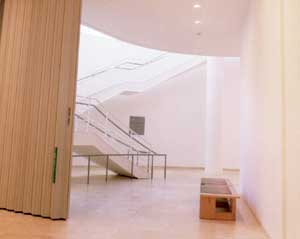Horizontal sliding-door Systems: Opening New Opportunities for Design Flexibility
The idea of doors not swinging for exit travel is a significant change, maybe one of the more significant changes in the building code for the last 60 years, Welch said. The change is in recognition of new technology that makes sliding-door systems ideal as both fire and smoke breaks and emergency exits, particularly for the disabled. This latter issue has been a primary concern for independent living and Universal Design advocates, because traditional swinging doors proved to be cumbersome for people in wheelchairs.
Universal Design is the approach to design that allows the use of the built environment by all people, regardless of age, ability or situation. It is an attempt to integrate accessibility requirements such as those under the Americans with Disabilities Act into one broad approach to make environments usable.
Emergency egress standards developed post-World War II in particular did not adequately consider the needs of the disabled. The problem was first recognized by Ed Roberts, a paraplegic appointed by then-California Governor Jerry Brown to be director of the state Department of Rehabilitation, who started thinking about how people with disabilities were supposed to escape from upper floors and buildings in general in the event of an emergency or fire. What happens if there's a power failure? People in wheelchairs obviously couldn't heed the admonition outside elevators that "in case fire, use the stairs." Safe staging areas for emergency evacuation were needed.
Interiors doors that were heavy and swung out or in posed another problem for those in wheelchairs. Getting the door open and getting through was unwieldy at best and sometimes impossible.
Sliding-door systems actually had an advantage in this regard. Manufacturers developed sensors, integrated processors, and motor technology that controlled the opening and closing of the partitions with maximum precision for any circumstance. Today's sliding-door systems can open with very little pressure, and have a manual override feature. Backup power systems are built in. In addition, a person in a wheelchair can simply bump into accordion-style sliding-door systems and they will spring open in an emergency. The systems also automatically stop closing if there's any obstruction, but then resume closing after a pause to maintain the integrity of the partition, similar to most elevator doors.
"A large horizontal sliding door in a fire-rated partition raises a number of questions: is it self-closing? What measures can be taken to prevent it from being blocked? What are the implications for someone trying to pass through the doorway as it is closing?" said A. Vernon Woodworth, AIA, principal in the Sullivan Code Group at the Boston-based R.W. Sullivan Engineering.
The use of electronic sensors and controls can address these concerns, Woodworth said. "This adds a new layer of complexity to building design and maintenance," he said. But, he said, "The issue of expectations and habit are key to behavior in the built environment, and doors are for people and their use. Side-swinging doors present obstacles for people in wheelchairs whereas sliding doors do not."
Opening a New Frontier: From Museums to Courthouses
In recent years, design professionals have been turning to horizontal accordion-style sliding door systems in museums, sports arenas, casinos, government facilities, entertainment and shopping venues, airports, and healthcare facilities. The use of the systems satisfies fire and building codes but allows considerable design flexibility. The accordion-style doors retract into wall recesses and hang from a ceiling track when closing, but require no track on the floor. The separation of internal spaces, the design of corridors leading to atriums and other open areas can thus be seamless and open in ways that were previously not possible.
|
Frank Gehry, FAIA, and his firm, Gehry Partners, LLP, used 10 fire-rated, horizontal accordion-style sliding-door systems in his acclaimed Guggenheim Museum at Bilbao, Spain, creating striking interior views among the interior exhibition spaces. Richard Meier, FAIA, and his firm, Richard Meier & Partners, Architects used 64 sliding-door systems at the J. Paul Getty Museum outside Los Angeles to accomplish a similar unobtrusive design for the collection of antiquities, Impressionist paintings, decorative art, and contemporary photography.
Tim Love, principal at the Boston-based architectural firm Utile, Inc., worked on the Getty villa, an extension of the museum that will open in January 2006, while at Machado and Silvetti, Associates, Inc., also based in Boston. sliding-doorsolutions are like "invisible fire breaks," he said: when retracted, they are actually hard to notice, allowing free-flowing passage among internal spaces. But they close and serve a critical function in a fire or other emergency.










